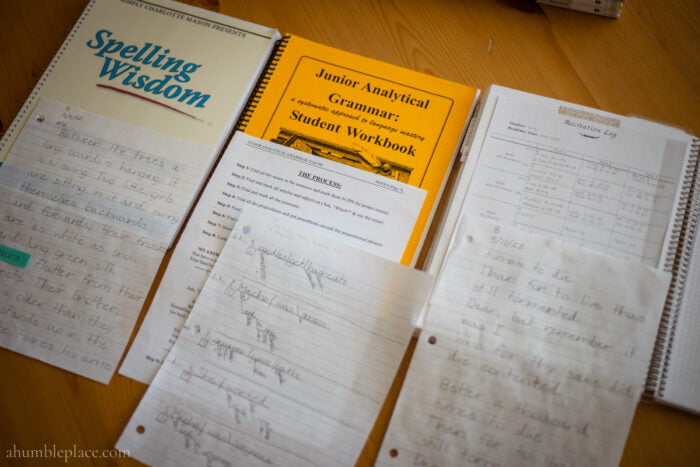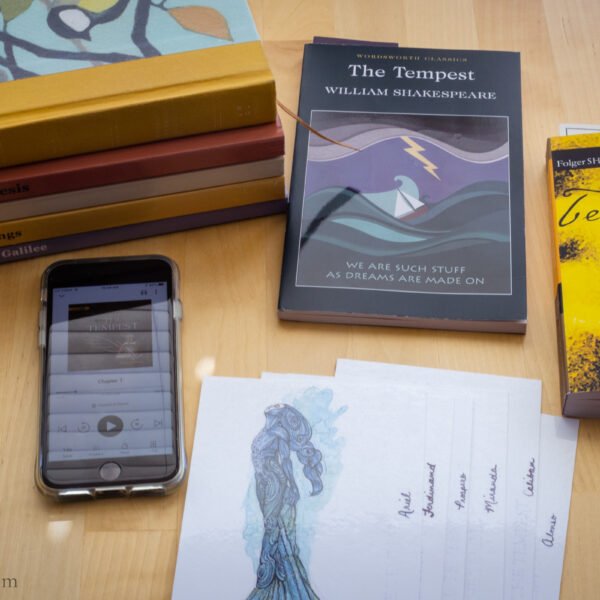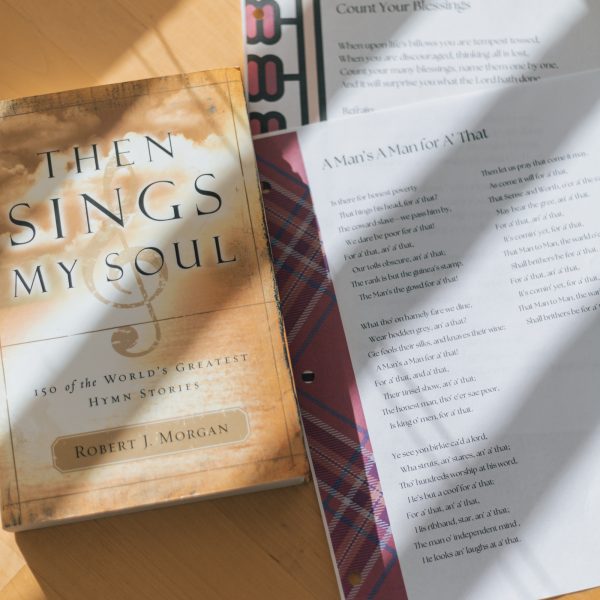Charlotte Mason Homeschool Language Arts Resources

The Charlotte Mason approach to homeschooling is a wonderful way of teaching language arts to your students. As with so many aspects of my children’s education, this aspect of learning looks wildly different from my own school years, particularly spelling, but I have seen that it really works, and works in a living way. Whereas I remember memorizing lists of disembodied words before being tested on them, these days, we read passages from classic literature when we begin our spelling lessons.
This is only part of how they learn language arts skills, though. Of course, there is copywork beginning with young children, and the addition of written narrations, dictation (or spelling), and grammar for older students.
But I feel the most significant part of learning “language arts” and general writing skills for us has come from following a main Charlotte Mason education principle: exposure to rich language through the use of living books. As Ms. Mason says, “They must grow up upon the best. There must never be a period in their lives when they are allowed to read or listen to twaddle or reading-made-easy. There is never a time when they are unequal to worthy thoughts, well put; inspiring tales, well told..” (Vol. 2).
Charlotte Mason language arts goes beyond the mechanics. When we present our children with rich language (even before they begin formal lessons) through living ideas, they will inevitably assimilate it, and it will become part of their vernacular. I have seen this many times, not only in their school work, but also in their creative writing endeavors. I have often been surprised at how much they understand and how many “big” words (correctly used!) pop out of their mouths. It’s fun to see.
I’m breaking this category down into the parts of our homeschool that I feel fall under the “Language Arts” banner but are specific to the Charlotte Mason method of education, including transcription (or copywork/handwriting), reading instruction, written narration, grammar, dictation (or spelling), and recitation. You can see Ambleside Online’s overview of Language Arts here.
Charlotte Mason Language Arts
Transcription (or Copywork/Handwriting)
Value of Transcription -The earliest practice in writing proper for children of seven or eight should be, not letter writing or dictation, but transcription, slow and beautiful work, for which the New Handwriting is to be preferred, though perhaps some of the more ornate characters may be omitted with advantage.
Transcription should be an introduction to spelling. Children should be encouraged to look at the word, see a picture of it with their eyes shut, and then write from memory.
Children should Transcribe favourite Passages. – A certain sense of possession and delight may be added to this exercise if children are allowed to choose for transcription their favourite verse in one poem and another. This is better than to write a favourite poem, an exercise which stales on the little people before it is finished. But a book of their own, made up of their own chosen verses, should give them pleasure.
Small Text-Hand – Double-ruled Lines – Double ruled lines, small text-hand, should be used at first, as children are eager to write very minute ‘small hand,’ and once they have fallen into this habit it is not easy to get good writing. A sense of beauty in their writing and in the lines they copy should carry them over this stage of their work with pleasure. Not more than ten minutes or a quarter of an hour should be given to the early writing-lessons. If they are longer the children get tired and slovenly.
Charlotte Mason (Home Education)
Resources
WorksheetWorks
Getty-Dubay Handwriting Series
AO Copywork Files by Year (this is in the AO Facebook group – search for “copywork”)
Articles
31 Days Of Charlotte Mason: What Is Copywork?
Slow and Beautiful Work
AmblesideOnline: Copywork
I allow my older students to pick their copywork selections, though my son usually doesn’t. Instead, he just copies his current recitation pieces. When he has gone through all of his recitation pieces, I use the AO copywork files linked above, which take excerpts from the books assigned in the AO schedule for specific years. My younger student is currently going through the Getty-Dubay Handwriting series, but when she finishes that, she will do the same copywork as her brother.
My hope is that they will both eventually choose their own copywork pieces and when (if? :)) that happens, I will get them their own commonplace books.
Reading
Resources
Teach Your Child to Read in 100 Easy Lessons
Bob Books
Treadwell Readers
Little Bear Books
Frog and Toad Books
I was always of the mindset to wait on formal reading instruction until my kids were ready for it (and there is evidence that waiting is a good thing). My son was very hesitant to learn to read, so we waited until he was older, and now he is a voracious reader. My daughter was chomping at the bit to learn how to read and was working on chapter books by the end of first grade. Every child is different!
Beginning in Year 1, we went through all of the lesson plans in the Teach Your Child to Read in 100 Easy Lessons book. I ended up dreading this part of our lesson time each day because this book is incredibly tedious, but it does what it says it will. These short lessons are tedious, but they are easy, and both of my kids were fluent readers even before we finished the book.
To break things up a bit, and because it was only 100 lessons, I opted to do three days per week with one lesson per day (or fifteen minutes, whichever was shorter) and then went through a Bob book on Thursdays (we go for a hike or attend our nature group on Fridays so we had no reading time on those days).
When we finished 100 Easy Lessons, we started the Treadwell Readers (each one includes short stories or excerpts from a living book) the first three days of the week, then continued with the Bob books on Thursdays. When we finished the Bob books, we started the Little Bear Books on Thursdays and then moved on to the Frog and Toad books while we finished the Treadwell Readers the first few days of the week.
After they finished all of the early reader books, through Year 3, I’ve had them read something from a chapter book (usually one of the AO free reads for their year) for ten minutes a day to me. Then in year 4, they begin doing some of the assigned readings on their own. I have found that this is one of the best ways for them to not only gain confidence in their reading, but also help them develop a love for great books.
I have seen that 100 Easy Lessons doesn’t work for every family, but I would choose to do it again if I had more students.
Written Narration
Narrating is an art, like poetry-making or painting, because it is there, in every child’s mind, waiting to be discovered, and is not the result of any process of disciplinary education. A creative fiat calls it forth. ‘Let him narrate’; and the child narrates, fluently, copiously, in ordered sequence, with fit and graphic details, with a just choice of words, without verbosity or tautology, so soon as he can speak with ease. This amazing gift with which normal children are born is allowed to lie fallow in their education. Bobbie will come home with a heroic narrative of a fight he has seen between ‘Duke’ and a dog in the street. It is wonderful! He has seen everything, and he tells everything with splendid vigour in the true epic vein; but so ingrained is our contempt for children that we see nothing in this but Bobbie’s foolish childish way! Whereas here, if we have eyes to see and grace to build, is the ground-plan of his education.
Charlotte Mason (Home Education)
Resources
Articles
Written Narration: The Next Step in Composition
AmblesideOnline: Narration
I wrote more about narration in general in my How to Get Started with Charlotte Mason Homeschooling post, so you can read more about it and see resources there. In a nutshell, oral narration is the telling back of whatever has just been read to or by the student in their own words and serves as a type of oral composition. Generally, this is done through Year 3, and then beginning in Year 4 (or Form II), students also start doing written narrations (while still continuing oral narration), which helps build their composition skills.
My older student was very reluctant to write, so we waited until Year 5 when he began doing one written narration per week. I have increased that yearly since and also allowed him to type out some of his narrations, which has increased his enthusiasm. I also see this as providing a strong foundation for developing his writing skills as a whole.
I’ll add that if you’re new to narration of any kind, including written narration, I can’t recommend Know and Tell enough. Karen Glass included many examples of oral and written narrations from different students that can give you a good idea of what most Charlotte Mason students are doing at a given age.

Grammar
Of grammar, Latin and English, I shall say very little here. In the first place, grammar, being a study of words and not of things, is by no means attractive to the child, nor should he be hurried into it. English grammar, again, depending as it does on the position and logical connection of words, is peculiarly hard for him to grasp… Because English grammar is a logical study, and deals with sentences and the positions that words occupy in them, rather than with words, and what they are in their own right, it is better that the child should begin with the sentence, and not with the parts of speech; that is, that he should learn a little of what is called analysis of sentences before he learns to parse; should learn to divide simple sentences into the thing we speak of, and what we say about it––’The cat––sits on the hearth’––before he is lost in the fog of person, mood, and part of speech.
Charlotte Mason (Home Education)
Resources
Articles
31 Days Of Charlotte Mason: On Grammar
AmblesideOnline: Grammar
We began grammar instruction in Year 4 with Junior Analytical Grammar per the recommendation of my friend Jennifer who used it with her kids. I like this program because it feels more conversational than the grammar lessons I grew up with, and each unit has a writing practice lesson called “playing with words.” As I mentioned above, my son is a reluctant writer, so this has been good practice for him.
We’ll most likely finish the Junior Analytical Grammar book by the end of this year or early next year, and then we’ll move on to the Mechanics book.
Dictation
Dictation lessons, conducted in some such way as the following, usually result in good spelling. A child of eight or nine prepares a paragraph, older children a page, or two or three pages. The child prepares by himself, by looking at the word he is not sure of, and then seeing it with his eyes shut. Before he begins, the teacher asks what words he thinks will need his attention. He generally knows, but the teacher may point out any word likely to be a cause of stumbling. He lets his teacher know when he is ready. The teacher asks if there are any words he is not sure of. These she puts, one by one, on the blackboard, letting the child look till he has a picture, and then rubbing the word out. If anyone is still doubtful he should be called to put the word he is not sure of on the board, the teacher watching to rub out the word when a wrong letter begins to appear, and again helping the child to get a mental picture. Then the teacher gives out the dictation, clause by clause, each clause repeated once. She dictates with a view to the pointing, which the children are expected to put in as they write; but they must not be told ‘comma,’ ‘semicolon,’ etc. After the sort of preparation I have described, which takes ten minutes or less, there is rarely an error in spelling. If there be, it is well worth while for the teacher to be on the watch with slips of stamp-paper to put over the wrong word, that its image may be erased as far as possible. At the end of the lesson, the child should again study the wrong word in his book until he says he is sure of, and should write it correctly on the stamp-paper.
Charlotte Mason (Home Education)
Resources
Spelling Wisdom
Post-it Page Markers
We also began dictation in Year 4 with Spelling Wisdom from Simply Charlotte Mason. I like these books because they include a collection of passages from living texts which the child is meant to look at, as outlined above, so there is nothing for me to prepare. I’m not sure what “stamp-paper” is, but the post-it page markers have worked well for us to cover up the misspelled words.
While we’re reading through the passage, we look for words that might be problematic, then I write them on a whiteboard to focus on them and remind him to look at them and close his eyes to try and visualize the word in his mind. Then I cover the passage and read it aloud to him, usually breaking it up by punctuation (e.g., giving him a section between commas or periods). Any misspelled words are covered with a post-it while he goes through the rest of the passage. It’s then uncovered, he studies the words he missed, then it’s covered again, and he tries those words a second time.
If he makes punctuation errors, I do not cover these, but when we’re done correcting the misspelled words, we’ll also correct the punctuation errors as well.
Recitation
Recitation and committing to memory are not necessarily the same thing, and it is well to store a child’s memory with a good deal of poetry, learnt without labour. Some years ago I chanced to visit a house, the mistress of which had educational notions of her own, upon which she was bringing up a niece. She presented me with a large foolscap sheet written all over with the titles of poems, some of them long and difficult: Tintern Abbey, for example. She told me that her niece could repeat to me any of those poems that I liked to ask for, and that she had never learnt a single verse by heart in her life. The girl did repeat several of the poems on the list, quite beautifully and without hesitation; and then the lady unfolded her secret. She thought she had made a discovery, and I thought so too. She read a poem through to E.; then the next day, while the little girl was making a doll’s frock, perhaps, she read it again; once again the next day, while E.’s hair was being brushed. She got in about six or more readings, according to the length of the poem, at odd and unexpected times, and in the end E. could say the poem which she had not learned.
Charlotte Mason (Home Education)
Resources
Free Recitation Guidelines and Student Log
Record of Recitations and Readings
Articles (read these before using the student log!)
That They Might Delight in Knowing
Ruminating on Recitation
Before each term begins, I look for recitation pieces for both students using the guidelines from the download linked above. For Bible passages, I look through whatever Bible readings we have assigned that term on the AO schedule and pull out the ones I think are especially good to know. For poetry, I ask my students what they’d like to learn for recitation or pick something from a poet we have assigned for that term (from the AO poetry schedule). We also learn two hymns and folksongs each term during Morning Time that are learned for recitation.
Once per day, each child stands in front of me and reads from their text for that day (Monday – Old Testament, Tuesday – New Testament, Wednesday – Psalm, Thursday – poem and we also sing our hymns and folksongs twice/week). The goal of Recitation is not necessarily memorization (though that does sometimes happen), but by reading these every week and getting to know the text intimately, the students can read them clearly, well, and with emotion, which has been a very neat part of our lesson time!
So these are the resources we use in our Charlotte Mason homeschool for Language Arts! In my next post in the series, I’ll be sharing our favorite resources for Math and Geography! If you’re not signed up for my newsletter, click here to get a notification when the new post is available!
Other posts in the series:


















What did you do to teach letters to kids before you started the teach your child to read in 100 lessons book? I have a 6 year old boy who is very uninterested in the learning of letters piece of this. He is supposed to be starting kindergarten in the fall but I’m not sure how it will go.
thanks
my daughter was not excited about it either and it took her a while. I read a lot of books to them outloud while they sat next to me and could look at the words. We also read a lot of alphabet books together where I’d point at the letter while I read it. We read these many times. And in kindergarten, I did the Bob Pre-Reader books with both of them as well. I feel like it was something they both kind of just picked up at some point….I tried not to pressure them into reciting the alphabet or quizzed them on letters…..it just kind of organically happened. Of course, this can be different for different kids!
thanks!
I’m really loving this series! My oldest is only 4, so we’re a ways off from getting to use most of this, but I am so excited for when we do!
I’m glad it’s been helpful!